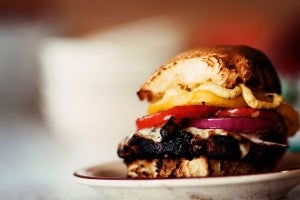
La página que intenta visitar sólo está disponible en inglés. ¡Disculpa!
The page you are about to visit is currently only available in English. Sorry!

 Photo courtesy of Martine Sansoucy |
It’s probably in your hamburger and your lean chunk, and you might not even know it.
Coined by a USDA scientist, pink slime is composed of beef trimmings that are mostly fat, says Donald W. Schaffner, a food scientist at Rutgers University. They’re collected and heated until liquefied. Then they’re put in a centrifuge so that the fat separates from the lean portion, similar to how butterfat is separated from milk. The lean portions are then collected and added to meat, often making for leaner, tender burgers.
Lean finely textured beef, or trimmings called pink slime, is not listed on labels stuck to ground beef packages, but there’s a high likelihood that it’s in there. The pink stuff’s renewed popularity is again prompting the gag reflex thanks to healthy school lunch advocate and chef Jamie Oliver, the USDA’s decision last week to allow schools to say no to these trimmings, The Lunch Tray blogger Bettina Siegel’s petition, and commitments from fast food chains to keep it out of their products.
The current controversy is over how the trimmings are treated with ammonia. Because they’re often cut from the outside of the meat, they have a higher chance of containing bacteria like E. coli, so they’re exposed to controlled concentrations of ammonia gas, something that celebrity chef Jamie Oliver discussed in a YouTube video.
“The idea that you’re going to take ammonia, which we’re all familiar with as a kitchen cleaning compound, and add that to my hamburger…people think that’s kind of disgusting,” says Schaffner. “From a scientific point of view, it’s a perfectly safe and rational process, but in people’s minds, it shouldn’t be something in their food.”
Ammonia exists naturally on many other foods, like oranges and cheese, something that often goes unnoticed, he says. There are no labeling requirements for pink slime, though, so if the idea of eating food with chemically treated trimmings grosses you out, ask your grocer if your ground beef contains lean finely textured beef. Another alternative is to buy all beef hamburgers.
A third option is to forego eating meat altogether, which might be the most environmentally friendly option. Beef cattle in the U.S. account for 160 million metric tons of greenhouse gas emissions annually, according to a Union of Concerned Scientists report published last year. That’s the same amount as the emissions from 24 million cars and light trucks.
Then there’s always eating the fake stuff. As food columnist Mark Bittman recently wrote about imitation chicken meat: “Isn’t it preferable, at least some of the time, to eat plant products mixed with water that have been put through a thingamajiggy that spews out meatlike stuff, instead of eating those same plant products put into a chicken that does its biomechanical thing for the six weeks of its miserable existence, only to have its throat cut in the service of yielding barely distinguishable meat?”
Even though the process of creating pink slime and adding it to ground beef is safe, it’s better to be informed. This post from the San Francisco Chronicle (based on a piece from The Daily) lists stores that sell meat with and without the pink stuff.